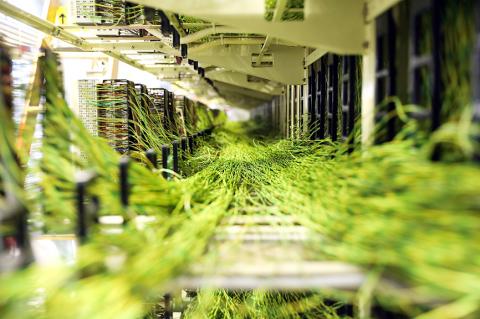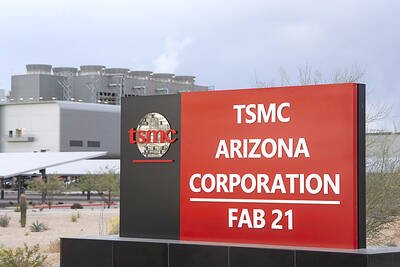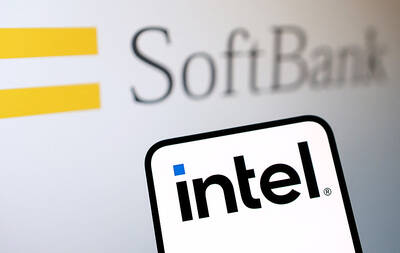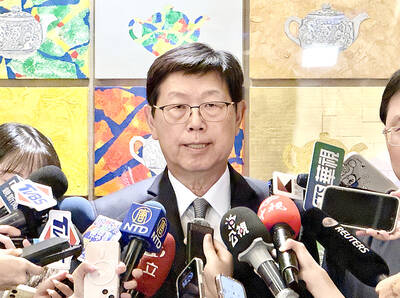Copper surrendered its biggest gain in seven years, and gold, silver and mining stocks tumbled as investors reassess the consequences of US president-elect Donald Trump’s stimulus plans.
Trump’s election victory on Tuesday ignited a frenzy of buying in industrial metals. However, on Friday, traders switched course as an equities rally stalled and the US dollar gained amid speculation over how his policies would affect the economy and monetary policy.
Copper trading volume was over four times average levels, while price swings in options were the highest since January, data compiled by Bloomberg show. Futures prices swung by US$0.24, giving investors and traders the opportunity to profit from the volatility by selling high and buying low throughout the trading hours. Gold’s 30-day historical volatility was the highest since August.

Photo: Bloomberg
“People fortunate or farsighted enough to be long options have had a very good day, but the exceptional volatility has claimed many casualties as well,” Tai Wong, director of commodity products trading at BMO Capital Markets in New York, said by telephone. “The price action in copper over the past 30 minutes has been particularly vicious.”
Copper futures for December delivery dropped 1.6 percent to settle at US$2.509 a tonne on the Comex in New York, after rising as much as 7.2 percent. For the week, the metal is up 11 percent. The 14-day relative strength index had reached 92, the highest recorded. A reading above 70 suggests an asset is overbought.
As the most-traded base metal and a barometer of economic growth, copper is also a proxy for investors’ views that Trump’s presidency will boost government spending on infrastructure. The rally, which started three weeks ago, has been fueled by speculative trading in China, which will cool later this year, Citigroup Inc said in a note.
Goldman Sachs Group Inc analysts, including Max Layton and Jeff Currie, said in a research note that copper’s rally could reverse abruptly in the first quarter on a pickup in supply and slowing demand and credit growth in China. The bank favors zinc and nickel for next year, which are either in deficit or more directly exposed to US stimulus, it said.
An increase in trading fees and margins on Chinese commodities exchanges is prompting speculators to trade copper on the London Metal Exchange (LME), Citigroup analysts, including David Wilson, wrote in an e-mailed note.
The Shanghai Futures Exchange on Thursday raised margin requirements for aluminum and other metals, after trading terms for iron ore, coal and other commodities were tightened by Chinese bourses. Shanghai nickel and copper were down.
While the surge “appears premature” and prices may fall toward the end of the year, stronger-than-expected Chinese factory data, falling global inventories and additional spending by China on its power network all point to higher prices in the medium term, Citigroup said.
Investors are also considering what a Trump presidency means for US Federal Reserve policy and the trajectory of rates. Odds for a December increase in borrowing costs have risen to 84 percent from 76 percent a week ago. That is bad for gold, with futures for December delivery falling 3.3 percent to US$1,224.30 an ounce on the Comex.
In other metals:
On the LME, aluminum, zinc, nickel, tin and lead also dropped. A gauge of 18 global base-metal producers tracked by Bloomberg Intelligence climbed as much as 1.8 percent before falling 0.5 percent, with Vedanta Resources PLC and Vale SA the biggest decliners.
An index of large gold producers fell 6.9 percent to the lowest since April as Harmony Gold Mining Co plunged 14 percent. Newmont Mining Corp fell 8.9 percent to close as the second-worst performer on the S&P 500 Index.
Silver futures for December delivery dropped 7.2 percent to US$17.382 an ounce, the biggest drop since January.

Taiwan Semiconductor Manufacturing Co (TSMC, 台積電), the world’s biggest contract chipmaker, booked its first-ever profit from its Arizona subsidiary in the first half of this year, four years after operations began, a company financial statement showed. Wholly owned by TSMC, the Arizona unit contributed NT$4.52 billion (US$150.1 million) in net profit, compared with a loss of NT$4.34 billion a year earlier, the statement showed. The company attributed the turnaround to strong market demand and high factory utilization. The Arizona unit counts Apple Inc, Nvidia Corp and Advanced Micro Devices Inc among its major customers. The firm’s first fab in Arizona began high-volume production

VOTE OF CONFIDENCE: The Japanese company is adding Intel to an investment portfolio that includes artificial intelligence linchpins Nvidia Corp and TSMC Softbank Group Corp agreed to buy US$2 billion of Intel Corp stock, a surprise deal to shore up a struggling US name while boosting its own chip ambitions. The Japanese company, which is adding Intel to an investment portfolio that includes artificial intelligence (AI) linchpins Nvidia Corp and Taiwan Semiconductor Manufacturing Co (TSMC, 台積電), is to pay US$23 a share — a small discount to Intel’s last close. Shares of the US chipmaker, which would issue new stock to Softbank, surged more than 5 percent in after-hours trading. Softbank’s stock fell as much as 5.4 percent on Tuesday in Tokyo, its

COLLABORATION: Softbank would supply manufacturing gear to the factory, and a joint venture would make AI data center equipment, Young Liu said Hon Hai Precision Industry Co (鴻海精密) would operate a US factory owned by Softbank Group Corp, setting up what is in the running to be the first manufacturing site in the Japanese company’s US$500 billion Stargate venture with OpenAI and Oracle Corp. Softbank is acquiring Hon Hai’s electric-vehicle plant in Ohio, but the Taiwanese company would continue to run the complex after turning it into an artificial intelligence (AI) server production plant, Hon Hai chairman Young Liu (劉揚偉) said yesterday. Softbank would supply manufacturing gear to the factory, and a joint venture between the two companies would make AI data

The Taiwan Automation Intelligence and Robot Show, which is to be held from Wednesday to Saturday at the Taipei Nangang Exhibition Center, would showcase the latest in artificial intelligence (AI)-driven robotics and automation technologies, the organizer said yesterday. The event would highlight applications in smart manufacturing, as well as information and communications technology, the Taiwan Automation Intelligence and Robotics Association said. More than 1,000 companies are to display innovations in semiconductors, electromechanics, industrial automation and intelligent manufacturing, it said in a news release. Visitors can explore automated guided vehicles, 3D machine vision systems and AI-powered applications at the show, along